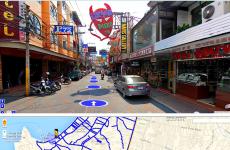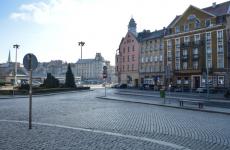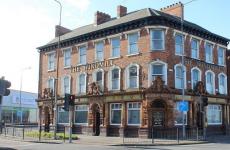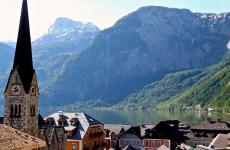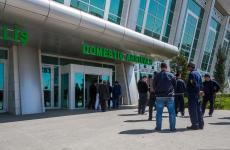Versailles in Paris. What is the best way to get to Versailles from Paris by public transport? How to get to Versailles from Paris on your own
Once in Paris, having explored the “most romantic” city on earth, tourists often strive to expand the boundaries of what they see. One of the most popular suburban destinations of the French capital is Versailles, a luxurious palace complex built by Louis XIV. In this article we will tell you how to get there to the former royal residence in every possible way. We hope that one of them will be to your liking and will be “tested in practice.”
Distance between Paris and Versailles- about 20 km.
The palace and the entire surrounding area are closed on Mondays (like many French museums). Before going on an excursion to Versailles, check to see if there are any public health or public holidays.
In Paris (almost every tourist office in the city) you will be offered sightseeing trips to Versailles. Think about it - maybe this is your option, because you don’t have to stand in lines and wait for transport, you are guaranteed a bus transfer and a tour with a personal or audio guide.
Such tours cost about 56 euros for adults and about 38 euros for children.
From Paris to Versailles by train
One of the most popular ways to get from Paris to Versailles is to use by RER trains(a system of high-speed trains connecting the suburbs with each other and with the city center). You need line C(“You can get hooked on it at the stations Musee d"Orsay, Les Invalides, Gare d"Austerlitz, St. Michel-Notre Dame, Invalides, Pont de l"Alma and Champ de Mars-Tour Eifell).
Travel time will take approximately 40 minutes, trains run every 20 minutes. The ticket costs about 7 euros (both directions) and can be purchased at the box office. Your stop - Versailles Rive Gauche. After getting off the train, cross the road and turn onto Rue de Paris, which is where you will reach in 10-15 minutes to the palace gates.
Trains in the opposite direction run as often as to Versailles.
For example, if you take the RER train at the Invalides stop at 8:26, you will arrive at Versailles just in time for opening (9:00).
Another way to get from Paris to Versailles by train is to take SNCF composition (Line L) from one of the Parisian train stations - Saint-Lazare(your stop is Versailles-Rive Droite) or Montparnasse (your stop is Versailles-Chanties). A ticket can be purchased at the box office, its one-way cost is about 3 euros. The trip will last 30 minutes, however, the station is located at a decent distance from the palace complex (on foot - 20-25 minutes).

Another way to get from Paris to Versailles is to first take the metro (line 9) to the station Pont de Sevres. Then go out into the city and take the bus number 171(the stop is located in close proximity to the metro exit). Buses run regularly 15-20 minutes. The scenic drive to Versailles will take you approximately 30-40 minutes. Note that the method is budget-friendly - a ticket purchased at the metro ticket office can also be used to travel on the bus.
Advice - exchange (if you have not already done so) your dollars or other currency for Euro. In Versailles (and throughout France), payments for tickets and other services/goods are accepted mainly in euros.
From Paris to Versailles by car
From Paris it is not difficult to get to Versailles by car. Using a car map or navigator, you enter the ring road, then onto the motorway A13, from which you turn according to the sign to Rouen. Next, you just have to follow the signs for Versailles. Travel time - 30 minutes. Parking the palace complex has quite a spacious, but paid. Its cost 5 euros in the first two hours and 12 euros- in 8 hours.
By the way, to calculate the route and select roads (toll or free routes), you can use a convenient resource.
Renting a car in Paris is easy - you can do it “live”, walking around the center of Paris, at the airport (perhaps the most expensive option) and online (convenient and best priced). All offers from international and local companies are collected on one website.
From Paris to Versailles by taxi
How to get from Paris to Versailles by taxi- the journey will take you about 50 minutes and it will cost from 60 euros. You can order a taxi on the KiwiTaxi website, which deals with intercity transfers. If you are traveling with a family of 3-4 people or a group of friends, a taxi from Paris to Versailles will be the fastest and most convenient way to get there. And by distributing the cost of a taxi among everyone, everyone will pay almost the same as for public transport. Another advantage is that you will not need to understand the nuances of public transport in Paris and its suburbs.

You can also get from Paris to Versailles by bicycle, but the distance between them is small and quite surmountable even for those who do not often travel by bicycle. You can rent “two-wheelers” in many tourist spots in Paris.
One of the most popular points - Raymond Poincare train station. Opening hours are usually from 7:00 to 20:00 (lunch break from 12:00 to 14:00) on weekdays and from 11:00 to 18:00 on weekends. The cost of renting a regular bicycle is 12 euros, electric - 20 euros in a day.
How to get from Paris to Versailles? This is a question that often arises among independent travelers. There are several opportunities to visit this luxurious palace complex. I'll tell you in order.
Having explored Paris, independent tourists strive to expand their borders and visit Versailles, the former royal residence, especially since the distance from Paris is only 20 km. I will tell you how to get to the palace complex in all possible ways.
I wrote more about Versailles. And before you go to explore the palace, check on the website whether it is open on that day.
By train
High-speed train RER
The easiest and most popular option is to travel by RER (Range Rapid Transit) train. Take line C (get on it at the stations Musee d'Orsay, Champ de Mars-Tour Eifell, Les Invalides, Pont de l'Alma, Invalides, St. Michel-Notre Dame, Gare d'Austerlitz) and go to the station Versailles Rive Gauche.
I advise you to buy 2 tickets at once, there and back, so as not to stand in line twice. At the box office, say that you need to go to Versailles, they will understand you. For both tickets you will spend about €7 (you need a ticket for zones 1-4). These tickets will be valid for travel on the metro, just validate them.
Travel time is 34 minutes. Trains run every 15 minutes. Get off at Versailles Rive Gauche station. When you get off the train, cross the road and turn onto Rue de Paris. After 10-15 minutes. you will reach the palace gates.
From Gare Saint-Lazare you can also get to Versailles. You need to take the SNCF train line L. The travel time is about the same, about 35 minutes. Your stop is Versailles-Rive Droite.
If you depart from Gare Montparnase, the travel time will be shorter - about 11 minutes. Get off at the Versailles-Chanties stop.
But remember, from the station to Versailles you have to walk about 20 minutes.
For information on train ticket prices and schedules, see.
By bus
Another inexpensive way to get to Versailles is by bus. You need to take the metro to Pont de Sevres station (line 9), get off and follow the signs to bus stop no. 171 (it’s next to the metro). Buses run every 15-20 minutes. from 06:00 to 24:00. The scenic bus ride to Versailles will take you approximately 30-40 minutes. To travel, use regular tickets, which are used to travel in zones 1-2 of Paris. See bus schedule No. 171.
Taxi
A taxi ride is comfortable, but it will cost you €50-60 one way.
By car
It is not difficult to get to Versailles from Paris by car; car maps or a navigator will help you. You can park in the parking lots at the Grand and Petit Trianon palaces, at the Bailly alley and at Army Square. Parking is paid.
You can rent a car in Paris while walking around the center, at the airport (an expensive option) or on the Internet (convenient and best priced).
By bike
The distance between Paris and Versailles is short and quite surmountable by bicycle, which can be rented in many tourist places in Paris. For example, at the Raymond Poincaré train station. The cost of renting a regular bike is €12 per day, an electric bike is €20.
Express buses
Any tourist office in Paris will offer you a tour of Versailles. And express buses will take you to the palace and back for half a day or a whole day, during the night fountain show. Combination tickets are available, which include travel and entry to the palace or show.
Traveling to Versailles by public transport and buying tickets yourself will cost you less than options offered by travel companies. But the direct bus has its advantages. Maybe this is your option. There is no need to stand in lines, wait for transport and a tour with a personal or audio guide.
I hope you will now solve the question of how to get from Paris to Versailles.
How do I save on hotels?
It’s very simple - look not only on booking. I prefer the search engine RoomGuru. He searches for discounts simultaneously on Booking and on 70 other booking sites.
Fabulous Palace of Versailles is a testament to the extravagance of the Sun King, Louis XIV. The palace and its beautiful formal garden became the main model for palaces throughout Europe.
- From Paris: 22 km from Paris, 35 minutes by car.
Opening hours of Versailles:
April - October:
- Palace 9:00 - 18:30, last entry 18:00, ticket office closes at 17:50. Closed on Mondays.
- Trianon Palace and Marie Antoinette's estate - 12:00 - 20:30, closed on Mondays.
- Garden - daily 8:00 - 20:30.
- Park - daily 7 - 19 for vehicles and 7 - 20:30 for pedestrians.
November - March
- palace 9:00 - 17:30, last entrance 17:00, ticket office closes at 16:50. Closed on Mondays.
- Trianon Palace and Marie Antoinette's estate - 12:00 - 17:30, closed on Mondays.
- Garden and park - daily, except Mondays, 8:00 - 18:00.

Entrance to Versailles:
- A ticket to the Palace of Versailles costs 15€ for adults (including audio guide), reduced price - 13 €, under 18 years old free.
- “Hidden Versailles” - with a guide, private apartments - 16 €.
- Trianon Palace and the estate of Marie Antoinette - 10 € (preferential - 6 €).
- Full Versailles: 18 €(25 € on days of musical concerts).
- Forfaits Loisirs combined ticket (all of Versailles + tickets from and to Paris)- 21.75 € on weekdays, 26 € on weekends. You can buy it at SNCF railway ticket offices. (the best option).
In summer after 15:00 entrance to the palace territory (park) for free.
The first Sunday of every month from November to March - free tour of the apartments, coronation room, Trianon Palace and Marie Antoinette's estate.
How to get to Versailles:
The most convenient way to get to Versailles from public transport is by direct train:
- : stop Versailles-Rive Gauche(ticket zone 1 - 4, regular T+ is not valid).
- : Versailles-Chantiers(from) or Versailles-Rive Droite(trains from Gare St-Lazare station). Travel time is about 20 minutes. Then walk to Versailles following the signs - about 15 minutes.
Train ticket to Versailles: 7.10 € in both directions, you need to select your final destination at the ticket machine - Versailles Rive Gauche.
Valid tickets: Paris Visite (1 - 5 zones) - from 11.15 €/day.
Train schedule to Versailles - RER C:
RER C route map (download PDF):
Maps of Versailles:
A Brief History of Versailles
Versailles is located about 20 kilometers from Paris. The first mention of the city and the estate was in 1038, when the name appeared in the charter of the abbey of Saint-Pere-de-Chartres. At the end of the 11th century, Versailles was a provincial village, encompassing a castle and the church of Saint-Julien, which remained prosperous until the early 13th century. After the Hundred Years' War, however, only a handful of people lived there.

Royal presence
In the 16th century, the Gondi family became rulers of Versailles, and the city became popular when the future King Louis XIII visited the area and was captivated by its beauty. In 1622, he bought land in the area and began building a small house of stone and brick.
Statue of Louis XIV
Ten years later he became the master of Versailles and began expanding his house. He soon acquired more land, as well as the Gondi property. Louis XIII died in 1643.
Sun King
In 1662, the new king, Louis XIV, turned out to be very interested in Versailles. Louis XIV, also known as the Sun King, did not trust the Parisians and wanted to move his royal residence away from the Louvre, which was constantly at the center of political turmoil. The Sun King was largely responsible for the expansion of Versailles, which resulted in the construction of a building that still stands today. He hired the architect Louis Le Vau and the artist Charles Lebrun to build this Baroque masterpiece, which became a typical example for all palaces in Europe. The famous gardener André Le Notre was responsible for the unsurpassed garden of Versailles.

Royal Chapel
After the death of the architect Le Vau, Jules Hardouin-Mansart was commissioned to triple the size of the palace. Under his watchful eye, the north and south wings, the Orangerie, the Grand Trianon (castle) and the royal chapel were built. Later the opera house and the Petit Trianon (small castle) were added, which was built between 1761 and 1764 for Louis XV and Madame de Pompadour.
French revolution
During the French Revolution, the incredible collection of paintings, antiques and other works of art that had accumulated at Versailles were transferred to the Palace, and other important items were sent to the National Library and Conservatory of Arts and Crafts. Most of the furniture, according to historians, was sold at auction.
Royal Palace
After the revolution, Napoleon spent the summer at Versailles until he abdicated the throne. Later, Louis Philippe lived here, who in 1830 turned the castle into a grand museum dedicated to the “Glory of France.” The Chapel, Opera, and Hall of Mirrors were preserved, but many of the smaller rooms were demolished to make way for spacious exhibition halls. However, in the 1960s, curator Pierre Werlet managed to get some of the furniture back and restore a number of royal apartments.
Today, visitors can visit Versailles, see much of the interior of this magnificent palace, as well as the world famous garden.
Versailles Museum:
Notable numbers include:
Hall of Mirrors
Some call the Hall of Mirrors Louis XIV's most notable contribution to Versailles. The main feature of the hall is the seventeen mirrored arches that reflect the seventeen arcaded windows that overlook the equally magnificent garden of Versailles. Each arch contains twenty-one mirrors, for a total of 357 mirrors in the room. This magnificent hall is 73 meters long, 10.5 meters wide and 12.3 meters high. Statues and busts line the walls. The Hall of Mirrors has always played an important role in history, including in 1919, when the First World War officially ended, Germany signed the Treaty of Versailles in this hall.
Royal Chapel
Currently, the chapel is already the fifth in the palace. Construction began in 1689 and was completed around 1710. There is a "tribune" on the same level as the royal apartments, overlooking the nave where the kings sat while attending mass. The architecture is a combination of Gothic and Baroque. Many of the chapel's features are reminiscent of medieval cathedrals, including the gargoyle and gabled roof, colored marble tiles on the floors, columns and carved pillars.

Grand - apartments
Originally known as the Apartments of the Planets (each of the 7-salons of these apartments has paintings of the planets), these were the apartments of King Louis XIV. While all the apartments are mesmerizing, most notable are the ceilings painted by the king's artist Charles Lebrenoy and his team of artists.

Royal Opera
The Opera's auditorium is made entirely of wood, making it one of the most acoustically “live” theaters in the world. Although it was a court theater and was not intended for a huge audience, it seats more than 700 people. Gold, pink and green dominate the decor of the Opera, whose construction was finally completed only in 1770. It was first used for the wedding ball of the future King Louis XVI and Marie Antoinette and boasts a unique mechanical system that raises the floor to stage level. Today the Opera is still used for concerts and opera performances.
Park geometry
Spread over 100 hectares, the garden of Versailles is the largest palace garden in Europe. It was created in the 17th century by landscape gardener André Le Nôtre, who designed what can be considered the quintessential French formal garden. The garden is laid out in a geometric pattern created by paths, shrubs, flower beds and trees. Le Nôtre also drained the swampy, sloping terrain and created a series of basins and a large canal known as the Grand Canal.
Latona Fountain
Several fountains decorate the pools. The most famous are the Latona Fountain - with a statue of the goddess Latona - and the Apollo Fountain - named after the sun god and depicting the sun king riding on chariots. There are several other fountains in the garden, such as the Neptune Fountain. The fountains were installed to entertain the many guests invited to King Louis XIV's lavish organized balls.
Another notable feature in the garden is the Colonnade, a circular row of marble columns designed by Jules Hardouin-Mansart.
Petit Trianon
Versailles also has several smaller palaces located in the garden: the Grand Trianon and the Petit Trianon. About 10,000 people worked at the Palace of Versailles, so privacy could not be counted on. Therefore, King Louis XIV ordered the construction of the Grand Trianon, a palace almost as luxurious as the main palace, where the king could escape the formalities of the court and have a tryst with his mistress. His successor, King Louis XV, later built an even smaller palace - Petit Trianon - for the same reason.


If you are planning a long-distance trip, you should remember a few simple but important rules: - carefully prepare your car for a long trip: check the level of engine oil, coolant, windshield washer fluid, make sure all lighting, etc. are functioning properly. - check the tire pressure. It is very important that it matches the pressure recommended for your vehicle. - prepare a spare tire and a tow rope - no one is immune from a tire puncture or breakdown on the highway, you should foresee possible troubles in advance and avoid them. - choose roads with high-quality surfaces - this will extend the life of your “iron horse” and save your nerves. When preparing for a trip, think through everything to the smallest detail so that the trip leaves pleasant memories and not a headache.
If you're in Paris, don't miss the opportunity to visit Versailles, located nearby. Versailles - there is so much luxury and wealth in this word. A long time ago, the French king Louis, nicknamed the “Sun King,” made Versailles his residence. Louis XIV's love for luxury and pomp is known to everyone. The King wanted to shine, so everything that surrounded the Sun King, especially his palace, shone.

The road from Paris to Versailles
The Palace of Versailles amazes visitors with its luxury. The palace is located in a small town that bears the same name at a distance of 20 kilometers from Paris. There is an option to get from Paris to Versailles on your own. This time there is no need to fly by plane, and there is no airport in Versailles. The journey by land will take no more than 40 minutes by train and about half an hour by bus. Let's look at several ways to get from Paris to Versailles:
1. The most popular way is high-speed train. It’s better to buy a round-trip ticket right away to save time standing in line. The train station is a ten-minute walk from the Versailles palace complex. If the weather is good, you can leisurely walk the entire route, enjoying the picturesque surroundings;
2. If road transport is more convenient, then following the signs and enjoying the picturesque view you can be in Versailles in 30 minutes, but you will have to pay for parking. It's very easy to rent a car in Paris;
3. If you don’t need a car, you can use a taxi. A taxi is convenient for those who travel with friends or family, since hiring a taxi for one is not very profitable;
4. Getting around by bicycle is very popular in Paris. You can rent a bicycle in any tourist place. The distance is small and it will not be difficult for a trained person to overcome it. At the same time, you can plan your travel time yourself and stop wherever you want for any time;
5. If you buy air tickets from Moscow to Paris on the website aviaoffer.ru, you can order a transfer from the Paris airport to Versailles and head there immediately after arriving in the capital of France;
6. You can purchase an excursion ticket in advance, the price of which will include round-trip travel, a visit to Versailles and the park area around it, and an audio guide. But this is a rather expensive service.
Palace of Versailles and its architecture
The Versailles complex is a unique combination of palace architecture and parkland. Many architects subsequently tried to imitate his style, but they failed to surpass the luxury and splendor of Versailles.
The Palace of Versailles has more than 700 rooms. Each of them amazes with its magnificence. The throne room makes a grandiose impression. It was here that Louis XIV amazed foreign ambassadors with his luxury and splendor and held balls. The most intriguing room in Versailles is the Gallery of Mirrors. There is a belief that the Mirror Gallery was furnished only with silver furniture. A huge number of mirrors decorated the gallery walls. Many mirrors were installed opposite the windows, this created the impression that the gallery had windows on both sides.
It is difficult to say what delights visitors more – the Palace of Versailles or the luxurious park around it. The park area is absolutely flat. It is impossible to find a single hill on it. A huge number of statues and fountains are located in the park. In order to see all their beauty and splendor, it is better to visit the park in spring or summer. During the cold season, the fountains do not work, and the statues are bundled up against the cold.
It is impossible to take your eyes off the water jets of the fountains dancing to the music. During the summer season, the park hosts celebrations with fireworks and light shows.
There are several elegant villas in the park. They were built under Louis XIV from pink marble. These villas were a place of retreat for kings.
You can talk as much as you like about the splendor of Versailles, its luxury and beauty. But as they say: “It’s better to see once than to hear a hundred times.” The surprising thing is that Versailles was born because of the envy of the Sun King towards the palace of his finance minister. And if not for this feeling, the world might not have received such a standard of architecture as Versailles.
